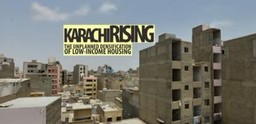Alternative routes to urban density
IIED, collaborating with local partners, embarked on a mission to redefine urban density's role in the lives of low-income groups in Karachi, Bangkok and Kathmandu. The goal was to eliminate the dichotomy between people being displaced to distant peripheries or crowding into substandard living conditions. The project concluded in 2015, leaving a legacy of insights and strategies.

A 'living room on the street' in Paposh Nagar, Karachi (Photo: Fareena Chanda)
Under the leadership of Arif Hasan, the IIED Human Settlements research group engaged with local partners to identify plot-based planning processes that could help to give low-income residents better access to the benefits, and avoid the costs of, densification.
This work includes case studies from three cities: Karachi, Bangkok and Kathmandu.
Even if low-income households in rapidly urbanising countries can find a place in the city, they often get pushed away as the city develops, land values increase and informal acceptance is replaced with formal rejection.
The project’s findings help show that an inclusive city is one that not only helps to make land available to its growing population, but protects people from involuntary displacement as the city grows, and land values increase.
This requires a planning process that facilitates the densification of low-income neighbourhoods, provided that residents directly benefit.
It also means giving residents the collective capacity to improve their neighbourhoods, and ensuring more security from eviction when investing in improvements.
This page features information previously gathered and presented on the ‘Alternative routes to urban density’ website that focused on Karachi, Pakistan; Bangkok, Thailand; and Kathmandu, Nepal.
News and updates
Publications
Additional resources
Drivers of climate change vulnerability at different scales in Karachi, Arif Hasan, Arif Pervaiz, Mansoor Raza (2020), IIED working paper
Geography of growth: spatial economics and competitiveness, Nelly Exbrayat (2013), Wiley Periodicals
The density debate: a personal view, Christine Whitehead (2012), London School of Economics and Political Science
Urban patterns for a green economy – leveraging density (2012), UN-HABITAT
Density and disasters: economics of urban hazard risk, Somik V. Lall, Uwe Deichmann (2012), The World Bank
Video: TEDxLahore, building better cities (2010)
The persistent decline in urban densities: global and historical evidence of ‘sprawl’, Shlomo Angel, Jason Parent, Daniel L. Civco, Alejandro Blei (2010), Lincoln Institute
Urban form and density in sustainable development, Shlomo Angel, Jason Parent, Daniel L. Civco (2010), Lincoln Institute
A planet of cities: urban land cover estimates and projections for all countries, 2000-2050, Shlomo Angel, Jason Parent, Daniel Civco, Alexander Blei, David Potere (2010), Lincoln Institute
A new map of global urban extent from MODIS satellite data, A Schneider, M A Friedl, D Potere (2009), Environmental Research Letters
Urban form, greenhouse gas emissions and climate vulnerability, David Dodman (2009), IIED report
















